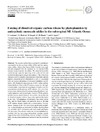Identificador persistente para citar o vincular este elemento:
https://accedacris.ulpgc.es/jspui/handle/10553/72279
| Título: | Forcing of dissolved organic carbon release by phytoplankton by anticyclonic mesoscale eddies in the subtropical NE Atlantic Ocean | Autores/as: | Lasternas, S. Piedeleu, M. Sangrá Inciarte, Pablo Duarte, C. M. Agusti, S. |
Clasificación UNESCO: | 2510 Oceanografía | Palabras clave: | Island-Generated Eddies North-Atlantic Sargasso Sea Food-Web Community Structure, et al. |
Fecha de publicación: | 2013 | Proyectos: | Remolinos Oceanicos y de Posición Atmosferica (Roda): Dinámica y Monitorización de Remolinos Oceanicos en la Corriente de Canarias | Publicación seriada: | Biogeosciences | Resumen: | The organic carbon fluxes mediated by planktonic communities in two cyclonic eddies (CEs) and two anticyclonic eddies (AEs) at the Canary Eddy Corridor were studied and compared with the dynamics in two far-field (FF) stations located outside the eddies. We observed favorable conditions and signs for upwelling at the center of CEs and for downwelling and mixing at the centers of AEs. CEs were characterized by a higher concentration of nutrients and the highest concentration of chlorophyll a (chl a), associated with the highest abundance of microphytoplankton and diatoms. AEs displayed concentrations of chl a values and nutrients similar to those at the FF stations, except for the highest ammonium concentration occurring at AE and a very low concentration of phosphorus at FF stations. AEs were transient systems characterized by an increasing abundance of pi-cophytoplankton and heterotrophic bacteria. While primary production was similar between the systems, the production of dissolved organic carbon (P-DOC) was significantly higher in the AEs. Phytoplankton cell mortality was lowest in the CEs, and we found higher cell mortality rates at AE than at FF stations, despite similar chl a concentration. Environmental changes in the AEs have been significantly prejudicial to phytoplankton as indicated by higher phytoplankton cell mortality (60% of diatoms cells were dead) and higher cell lysis rates. The adverse conditions for phytoplankton associated with the early-stage anticyclonic systems, mainly triggered by active downwelling, resulted in higher cell mortality, forcing photosynthesized carbon to fuel the dissolved pool. | URI: | https://accedacris.ulpgc.es/handle/10553/72279 | ISSN: | 1726-4170 | DOI: | 10.5194/bg-10-2129-2013 | Fuente: | Biogeosciences [ISSN 1726-4170], v. 10 (3), p. 2129-2143, (2013) |
| Colección: | Artículos |
Citas SCOPUSTM
19
actualizado el 08-jun-2025
Citas de WEB OF SCIENCETM
Citations
18
actualizado el 08-jun-2025
Visitas
47
actualizado el 11-ene-2026
Descargas
67
actualizado el 11-ene-2026
Google ScholarTM
Verifica
Altmetric
Comparte
Exporta metadatos
Los elementos en ULPGC accedaCRIS están protegidos por derechos de autor con todos los derechos reservados, a menos que se indique lo contrario.
